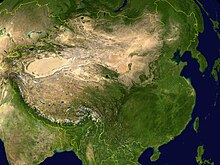Environment of China

The environment of China comprises diverse biotas, climates, and geologies. Rapid industrialization, population growth, and lax environmental oversight have caused many environmental issues and large-scale pollution.[1]
Geology
This section is empty. You can help by adding to it. (September 2012) |
Biota
Wildlife

Flora
Climate
Climate change
The position of the Chinese government on climate change is contentious. China is the world's current largest emitter of carbon dioxide although not the cumulative largest. China has ratified the Kyoto Protocol, but as a non-Annex I country is not required to limit greenhouse gas emissions under terms of the agreement.
Protected areas of China
There are several forms of protected areas in China.
Environmental issues


Rapid industrialization, population growth, and lax environmental oversight have caused many environmental issues, such as large-scale pollution in China.[2] As of 2013 Beijing, which lies in a topographic bowl, has significant industry, and heats with coal, is subject to air inversions resulting in extremely high levels of pollution in winter months.[3]
In January 2013, fine airborne particulates that pose the largest health risks, rose as high as 993 micrograms per cubic meter in Beijing, compared with World Health Organization guidelines of no more than 25. The World Bank estimates that 16 of the world's most-polluted cities are located in China.[4]
According to Jared Diamond, the six main categories of environmental problems of China are: air pollution, water problems, soil problems, habitat destruction, biodiversity loss and mega projects.[5] And "China is noted for the frequency, number, extent, and damage of its natural disasters".[5]
See also
- Environmental policy in China
- Geographic Information Systems in China
- Hot summer cold winter zone
- Land use in China
References
- ^ Edward Wong (21 March 2013). "As Pollution Worsens in China, Solutions Succumb to Infighting". The New York Times. Retrieved 22 March 2013.
- ^ Edward Wong (29 March 2013). "Cost of Environmental Damage in China Growing Rapidly Amid Industrialization". The New York Times. Retrieved 30 March 2013.
- ^ "2 Major Air Pollutants Increase in Beijing". The New York Times. 3 April 2013. Retrieved 4 April 2013.
- ^ Bloomberg News (14 January 2013). "Beijing Orders Official Cars Off Roads to Curb Pollution". Bloomberg. Retrieved 27 July 2013.
- ^ a b Jared Diamond, Collapse: How Societies Choose to Fail or Succeed, Penguin Books, 2005 and 2011 (ISBN 9780241958681). See chapter 12 entitled "China, Lurching Giant" (pages 258-377).
